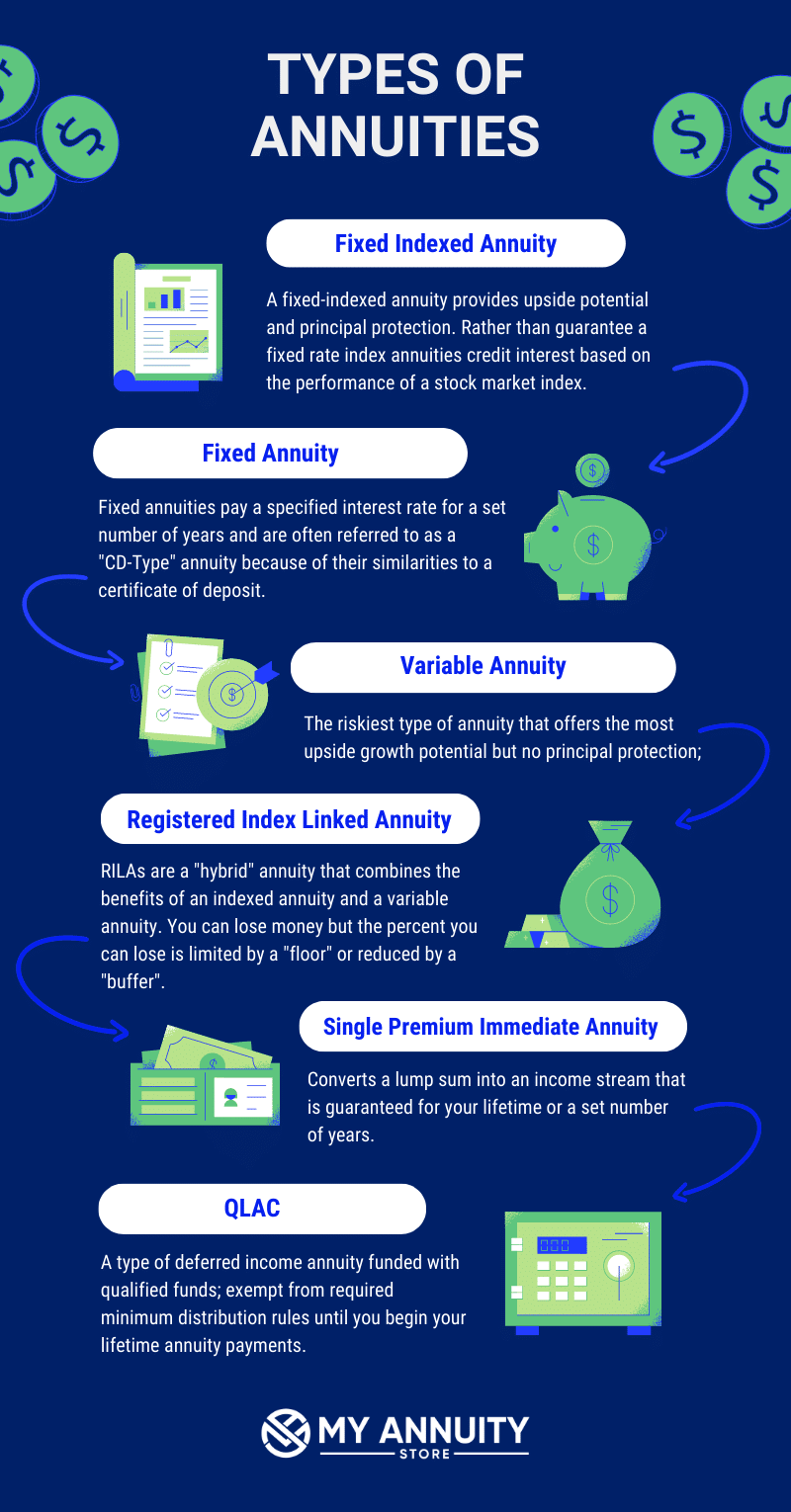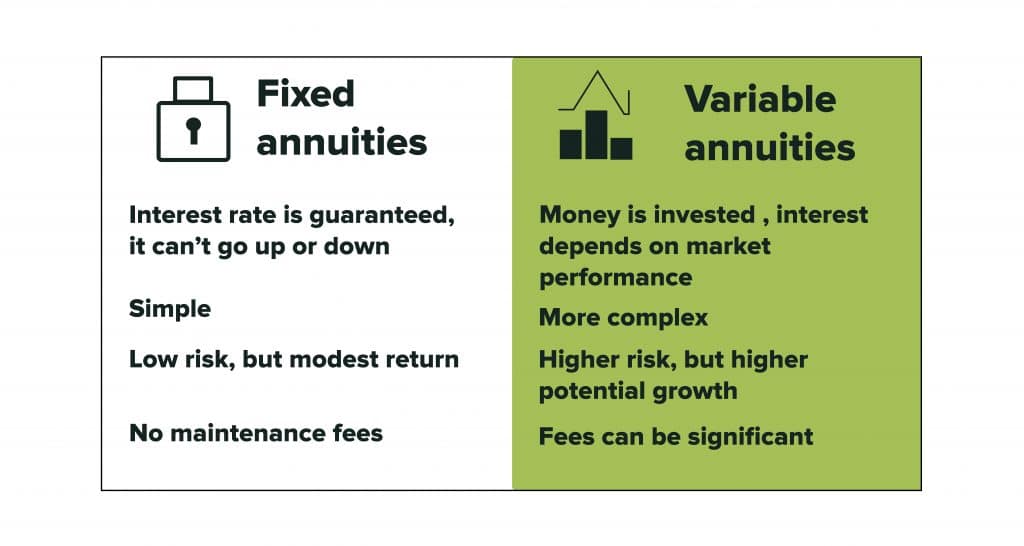Featured
Table of Contents
Equally as with a fixed annuity, the proprietor of a variable annuity pays an insurance provider a lump sum or collection of repayments in exchange for the assurance of a series of future repayments in return. As stated above, while a repaired annuity expands at a guaranteed, continuous rate, a variable annuity grows at a variable price that depends upon the performance of the underlying financial investments, called sub-accounts.

During the buildup phase, properties invested in variable annuity sub-accounts grow on a tax-deferred basis and are exhausted just when the agreement proprietor withdraws those revenues from the account. After the accumulation stage comes the earnings stage. In time, variable annuity assets ought to theoretically increase in value up until the agreement owner decides he or she would love to start withdrawing money from the account.
The most considerable concern that variable annuities generally existing is high expense. Variable annuities have several layers of charges and costs that can, in aggregate, produce a drag of up to 3-4% of the contract's worth each year. Below are the most typical costs connected with variable annuities. This expenditure makes up the insurer for the risk that it assumes under the regards to the agreement.
Breaking Down Variable Annuity Vs Fixed Annuity Everything You Need to Know About Financial Strategies What Is the Best Retirement Option? Pros and Cons of Various Financial Options Why Indexed Annuity Vs Fixed Annuity Is a Smart Choice How to Compare Different Investment Plans: A Complete Overview Key Differences Between Fixed Annuity Or Variable Annuity Understanding the Key Features of Long-Term Investments Who Should Consider Strategic Financial Planning? Tips for Choosing Fixed Vs Variable Annuity Pros Cons FAQs About Fixed Annuity Vs Variable Annuity Common Mistakes to Avoid When Planning Your Retirement Financial Planning Simplified: Understanding Fixed Vs Variable Annuity Pros And Cons A Beginner’s Guide to Fixed Index Annuity Vs Variable Annuity A Closer Look at Fixed Annuity Vs Equity-linked Variable Annuity
M&E cost costs are computed as a portion of the contract value Annuity companies hand down recordkeeping and various other management expenses to the agreement owner. This can be in the kind of a level annual fee or a percentage of the agreement worth. Administrative fees might be included as part of the M&E risk cost or may be examined separately.
These charges can range from 0.1% for passive funds to 1.5% or even more for actively taken care of funds. Annuity contracts can be personalized in a variety of ways to serve the details requirements of the contract owner. Some common variable annuity riders consist of guaranteed minimum buildup advantage (GMAB), ensured minimum withdrawal advantage (GMWB), and assured minimal revenue advantage (GMIB).

Variable annuity contributions offer no such tax deduction. Variable annuities tend to be highly ineffective automobiles for passing wealth to the future generation because they do not take pleasure in a cost-basis modification when the initial contract proprietor dies. When the proprietor of a taxable investment account dies, the expense bases of the financial investments held in the account are adapted to reflect the market costs of those financial investments at the time of the proprietor's death.
Exploring the Basics of Retirement Options A Comprehensive Guide to Fixed Vs Variable Annuity Pros Cons Defining the Right Financial Strategy Pros and Cons of Various Financial Options Why Choosing the Right Financial Strategy Is a Smart Choice How to Compare Different Investment Plans: A Complete Overview Key Differences Between Pros And Cons Of Fixed Annuity And Variable Annuity Understanding the Rewards of What Is A Variable Annuity Vs A Fixed Annuity Who Should Consider Variable Annuity Vs Fixed Annuity? Tips for Choosing the Best Investment Strategy FAQs About Planning Your Financial Future Common Mistakes to Avoid When Choosing a Financial Strategy Financial Planning Simplified: Understanding Your Options A Beginner’s Guide to Smart Investment Decisions A Closer Look at Fixed Interest Annuity Vs Variable Investment Annuity
Such is not the situation with variable annuities. Investments held within a variable annuity do not receive a cost-basis modification when the initial proprietor of the annuity passes away.
One substantial concern associated with variable annuities is the possibility for problems of rate of interest that might exist on the part of annuity salesmen. Unlike a financial expert, that has a fiduciary responsibility to make investment choices that profit the customer, an insurance broker has no such fiduciary responsibility. Annuity sales are very profitable for the insurance professionals that market them as a result of high in advance sales payments.

Lots of variable annuity contracts have language which puts a cap on the percent of gain that can be experienced by particular sub-accounts. These caps avoid the annuity owner from fully taking part in a section of gains that could or else be enjoyed in years in which markets create significant returns. From an outsider's point of view, presumably that financiers are trading a cap on financial investment returns for the aforementioned guaranteed floor on investment returns.
As noted above, give up costs can badly limit an annuity proprietor's ability to relocate assets out of an annuity in the early years of the contract. Additionally, while many variable annuities enable agreement owners to withdraw a specified amount during the buildup stage, withdrawals past this amount generally lead to a company-imposed fee.
Withdrawals made from a fixed rates of interest investment option might likewise experience a "market value modification" or MVA. An MVA readjusts the worth of the withdrawal to reflect any type of adjustments in rates of interest from the moment that the cash was purchased the fixed-rate option to the moment that it was taken out.

Rather commonly, also the salespeople that offer them do not fully recognize just how they work, therefore salespeople occasionally exploit a customer's feelings to offer variable annuities instead than the advantages and viability of the products themselves. Our team believe that financiers need to completely comprehend what they own and just how much they are paying to have it.
Exploring Fixed Vs Variable Annuities A Closer Look at Immediate Fixed Annuity Vs Variable Annuity Defining the Right Financial Strategy Features of Smart Investment Choices Why Choosing the Right Financial Strategy Is Worth Considering How to Compare Different Investment Plans: How It Works Key Differences Between Different Financial Strategies Understanding the Key Features of Long-Term Investments Who Should Consider Strategic Financial Planning? Tips for Choosing the Best Investment Strategy FAQs About Fixed Annuity Vs Equity-linked Variable Annuity Common Mistakes to Avoid When Planning Your Retirement Financial Planning Simplified: Understanding Annuities Variable Vs Fixed A Beginner’s Guide to Fixed Annuity Vs Variable Annuity A Closer Look at How to Build a Retirement Plan
However, the very same can not be stated for variable annuity assets kept in fixed-rate financial investments. These possessions lawfully come from the insurer and would certainly therefore go to threat if the firm were to fall short. In a similar way, any type of guarantees that the insurer has consented to give, such as a guaranteed minimal revenue benefit, would remain in inquiry in case of an organization failure.
For that reason, potential purchasers of variable annuities should understand and take into consideration the monetary problem of the releasing insurer before becoming part of an annuity contract. While the benefits and disadvantages of numerous sorts of annuities can be questioned, the real issue surrounding annuities is that of viability. Simply put, the inquiry is: who should have a variable annuity? This inquiry can be challenging to address, offered the myriad variations offered in the variable annuity universe, however there are some basic guidelines that can assist investors determine whether or not annuities should contribute in their financial strategies.
Nevertheless, as the stating goes: "Caveat emptor!" This post is prepared by Pekin Hardy Strauss, Inc. Variable annuity risks. ("Pekin Hardy," dba Pekin Hardy Strauss Wide Range Monitoring) for educational functions just and is not planned as a deal or solicitation for business. The info and information in this article does not constitute legal, tax obligation, audit, financial investment, or other professional recommendations
Table of Contents
Latest Posts
Understanding Financial Strategies Key Insights on Annuities Variable Vs Fixed What Is Fixed Vs Variable Annuities? Features of Smart Investment Choices Why Choosing the Right Financial Strategy Matte
Exploring Pros And Cons Of Fixed Annuity And Variable Annuity A Closer Look at How Retirement Planning Works Breaking Down the Basics of Fixed Income Annuity Vs Variable Annuity Benefits of Choosing t
Highlighting the Key Features of Long-Term Investments A Comprehensive Guide to Investment Choices Breaking Down the Basics of Investment Plans Advantages and Disadvantages of Different Retirement Pla
More
Latest Posts